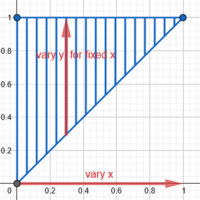(a) Prove that the following is a joint probability density function.
[imath]\displaystyle f(x,y,z,t) = \begin{cases} \frac{1}{xyz} & \ \ \ ,0<t\leq z\leq y\leq x\leq 1 \\ 0 & \ \ \ , \text{elsewhere} \end{cases} [/imath]
(b) Suppose that [imath]f[/imath] is the joint probability density function of random variables [imath]X, Y, Z, \text{and} \ T[/imath]. Find [imath]f_{Y,Z,T}(y,z,t), f_{X,T(x,t)}, \text{and} \ f_{Z(z)}.[/imath]
My attempt.
In part (a), it wants me to solve the integral of the function [imath]f(x,y,z,t)[/imath]. The answer must equal to [imath]1[/imath].
[imath]\displaystyle \int\int\int\int \frac{1}{xyz} \ dx \ dy \ dz \ dt[/imath]
The domain is confusing. How to sit the limits of integration?
In part (b), I am totally lost.
[imath]\displaystyle f(x,y,z,t) = \begin{cases} \frac{1}{xyz} & \ \ \ ,0<t\leq z\leq y\leq x\leq 1 \\ 0 & \ \ \ , \text{elsewhere} \end{cases} [/imath]
(b) Suppose that [imath]f[/imath] is the joint probability density function of random variables [imath]X, Y, Z, \text{and} \ T[/imath]. Find [imath]f_{Y,Z,T}(y,z,t), f_{X,T(x,t)}, \text{and} \ f_{Z(z)}.[/imath]
My attempt.
In part (a), it wants me to solve the integral of the function [imath]f(x,y,z,t)[/imath]. The answer must equal to [imath]1[/imath].
[imath]\displaystyle \int\int\int\int \frac{1}{xyz} \ dx \ dy \ dz \ dt[/imath]
The domain is confusing. How to sit the limits of integration?
In part (b), I am totally lost.

